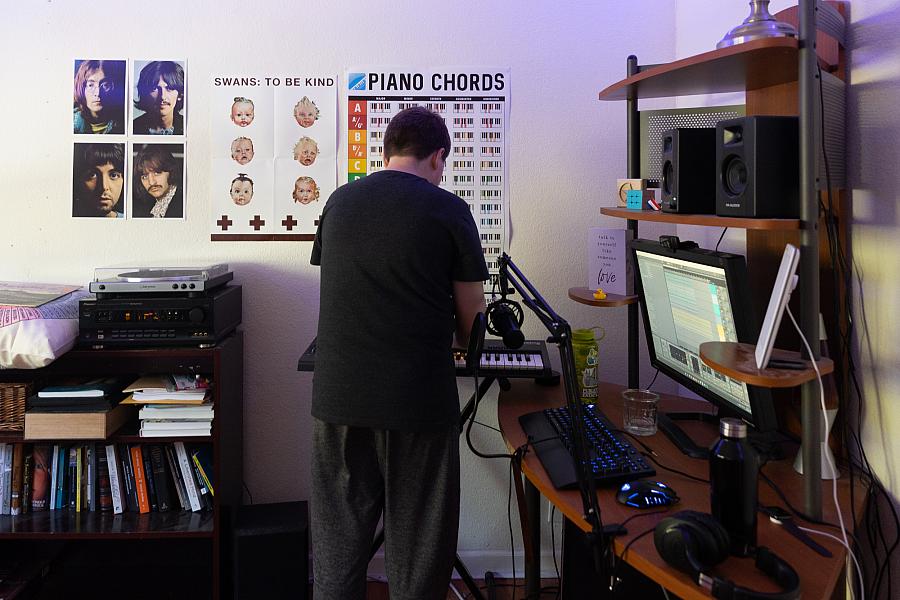Avoiding the sunk cost fallacy when a project takes an unexpected turn

Brian, a Palo Alto teen who has struggled to find adequate mental health treatment. I found him and his mom after posting in a local parent Facebook group asking if anyone was interested in sharing their experiences with me. Brian is a pseudonym to protect his anonymity.
(Photo via Malea Martin)
When I first embarked on my fellowship project, I was in about as comfortable a place as one can be as a journalist: I had a fully fleshed-out story pitch, multiple sources already on the record, and five whole months to pull it all together. But when some unforeseen changes forced me to pivot and step out of my comfort zone as a reporter, I ended up learning some valuable lessons about creating meaningful community journalism that engages your readers.
When I found out I was selected as a fellow, I was reporting for New Times San Luis Obispo, a weekly paper serving communities in San Luis Obispo County. I’d been hearing for months about the primary care physician shortage that people in SLO County face. I knew this was the story I wanted to pitch. My story proposal was already backed by multiple sources affirming the issue, and I felt more than ready to tackle the project. It felt like my application wrote itself.
But about a month into the fellowship, I found myself with an exciting new career opportunity at the Mountain View Voice, an online publication in Silicon Valley covering a very different community than I was used to reporting on.
After accepting the new position, at first, I was determined to make my original project proposal work for this new community. I’d heard that the physician shortage was rampant across California, and I had already invested so much time in this project. It felt too painful to just let that work go to waste.
But as I spoke to local experts and got to know the community better, it soon became clear that my original pitch wasn’t right for my new coverage area. There were primary care physician shortages in Santa Clara County, too, but person after person I spoke to was far more concerned about the severe lack of child and adolescent mental health care providers in Silicon Valley.
At first I felt frustrated by having to change my project scope. I went from feeling ahead of the game to being behind the rest of the reporters in my fellowship class. But having now finished my project, I’m so grateful that I listened to the folks I talked to and wrote about the issues that matter to my new community, rather than forcing my original idea to fit.
As reporters, it’s easy to fall victim to the “sunk cost fallacy”: the feeling that you need to see a story through simply because you’ve already invested significant time on it. But what I learned from going through this experience was that my time wasn’t actually wasted at all: trial and error is an essential part of finding the story that really needs to be told.
Another big lesson I learned from this project is that you cannot make assumptions about the people you’re writing about. Going into a story with assumptions, even subconsciously, can make the folks you speak with feel isolated and unheard. Engagement journalism means talking to people not just to use them as sources, but to understand your audience, to genuinely get to know the problems they’re facing. If that conversation ends up becoming your lede or a perfect source for your story, then that’s great, but the first goal of engagement shouldn’t be to get a quote or prove an assumption you made about your subject material.
The fellowship helped me to refine engagement tools that I already had in my toolbox, but perhaps ones that I didn’t know how to use very well, which proved immensely helpful to my project. I had used Facebook to find sources at my last publication, but I often posted in general community groups. This time, I tried a new approach: I joined parent and caregiver Facebook groups in my new coverage area, because I knew these were the folks who were most likely to care about the child mental health care provider shortage.
Another lesson I learned was to keep my search for sources open ended. In the past, I might have posted something like, “I’m looking for sources to talk on the record with me about the challenges of finding mental health care for their kids.” But I learned that this type of post can turn people off from speaking to you, as it implies that you only want to talk to them if they’re willing to be quoted, and it makes assumptions about their experience.
Instead, I tried posting things like “I’m looking to talk to folks about their experiences accessing mental health care for their children.” I think this made people feel more comfortable to reach out to me, even if they didn’t want to be on the record, which in turn informed the direction that my project went in. It also encouraged folks with all types of different experiences to reach out, not just people who have had a hard time finding care, which made my reporting more nuanced and less assumptive.
This approach based in community engagement helped me find the key voices for my project, sources that I never would have found through traditional reporting methods. When my project was published, it was rewarding to go back and post a link in the same groups I originally posted in, and interact with my readers on a more individual level.

